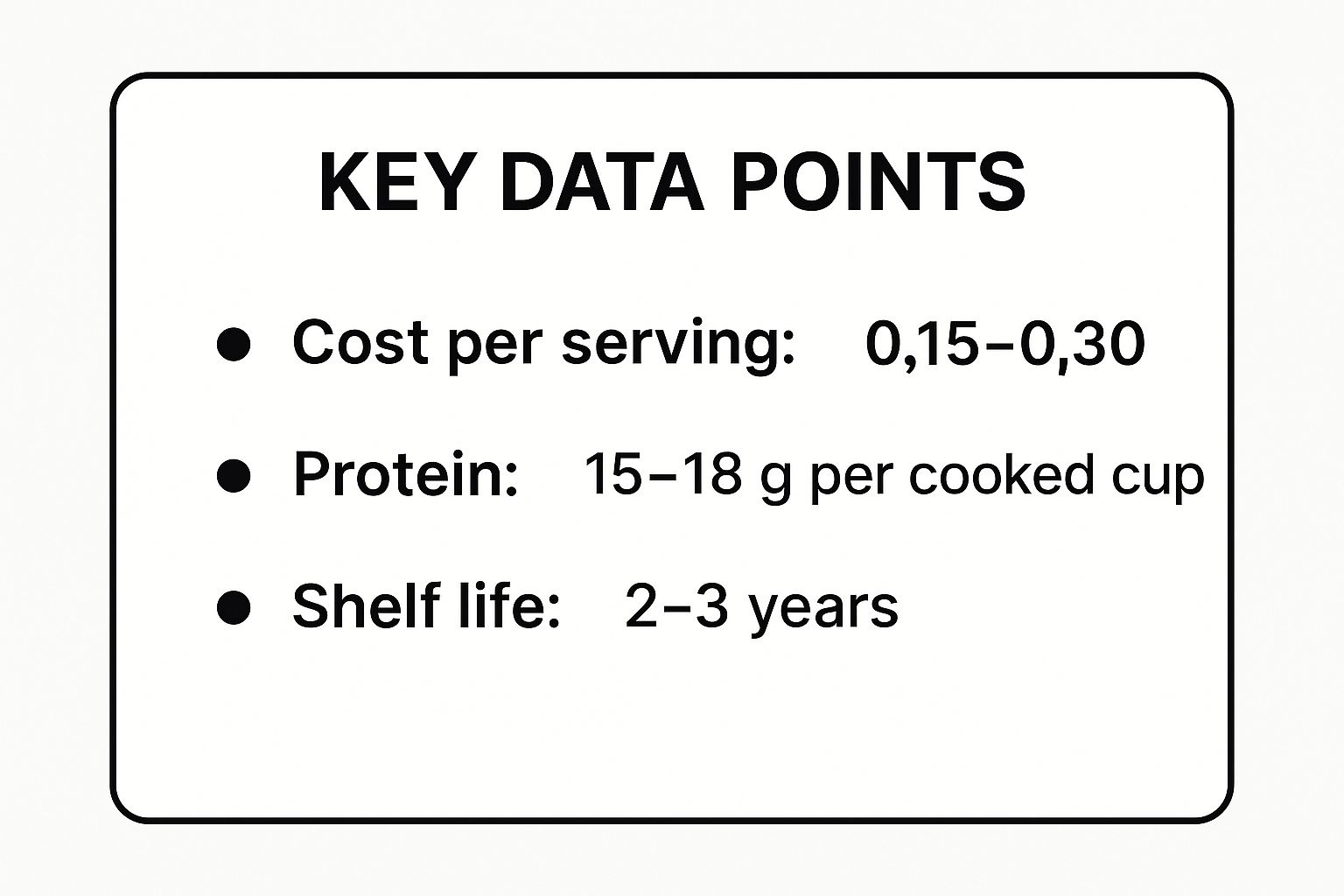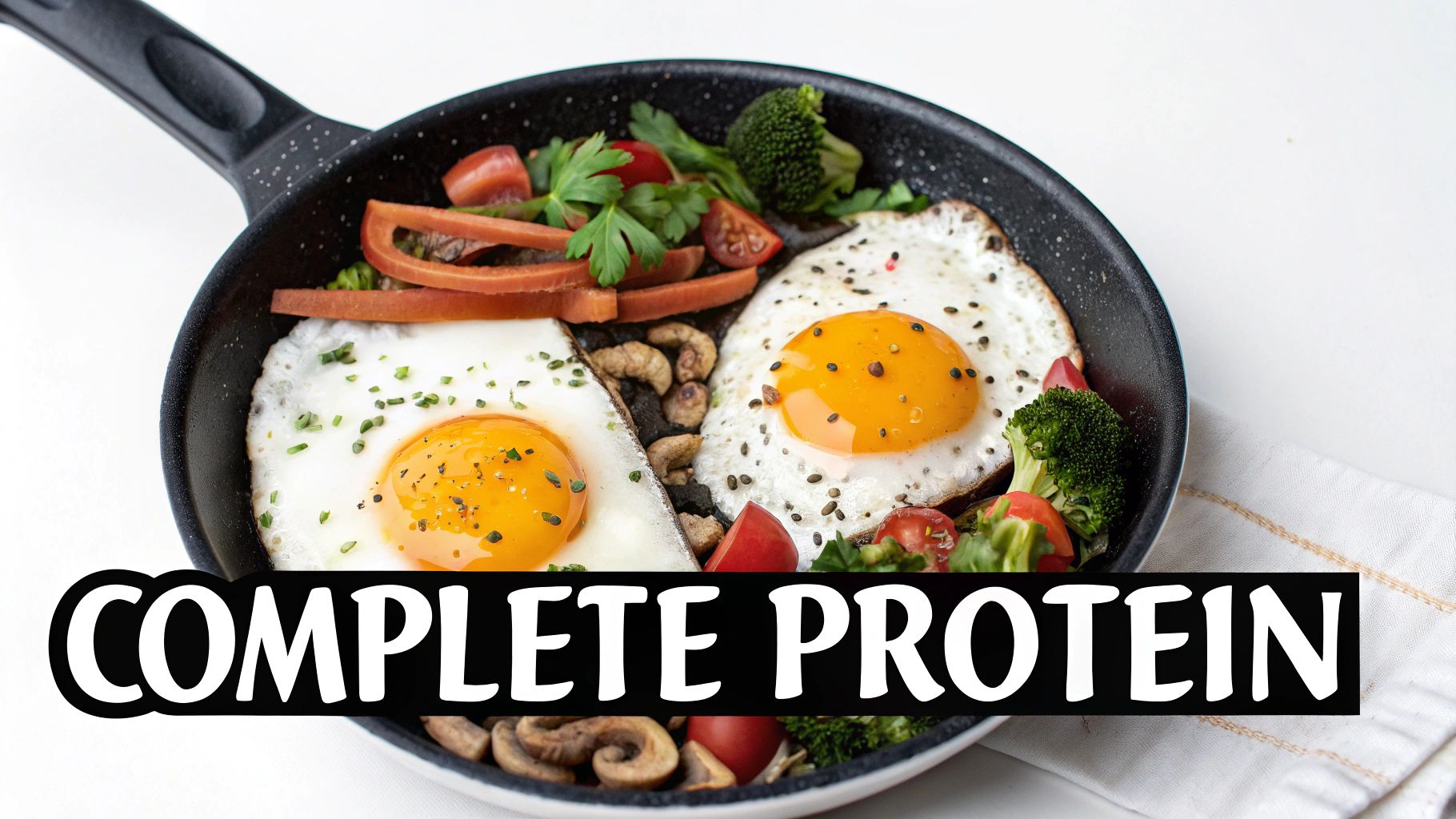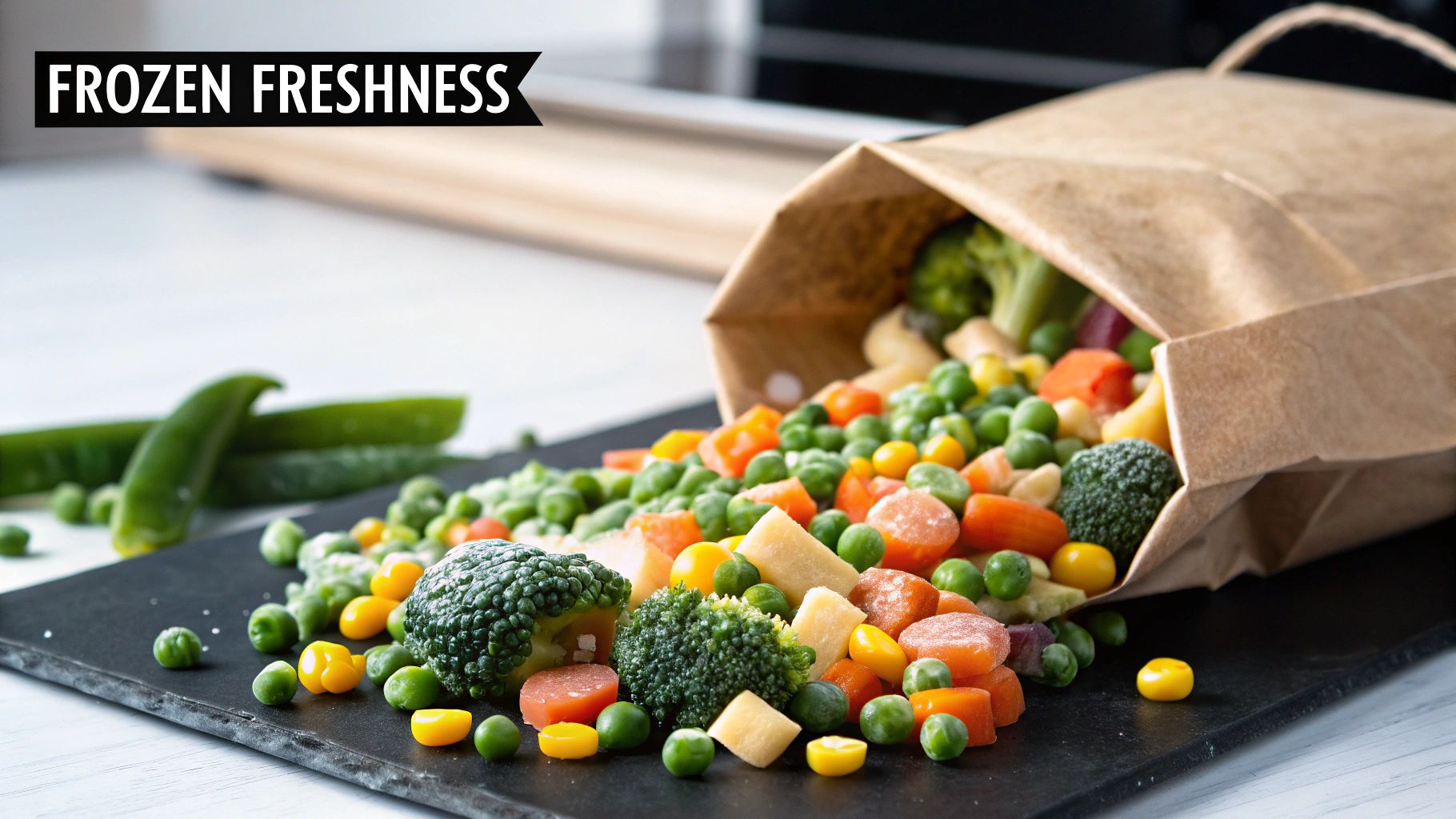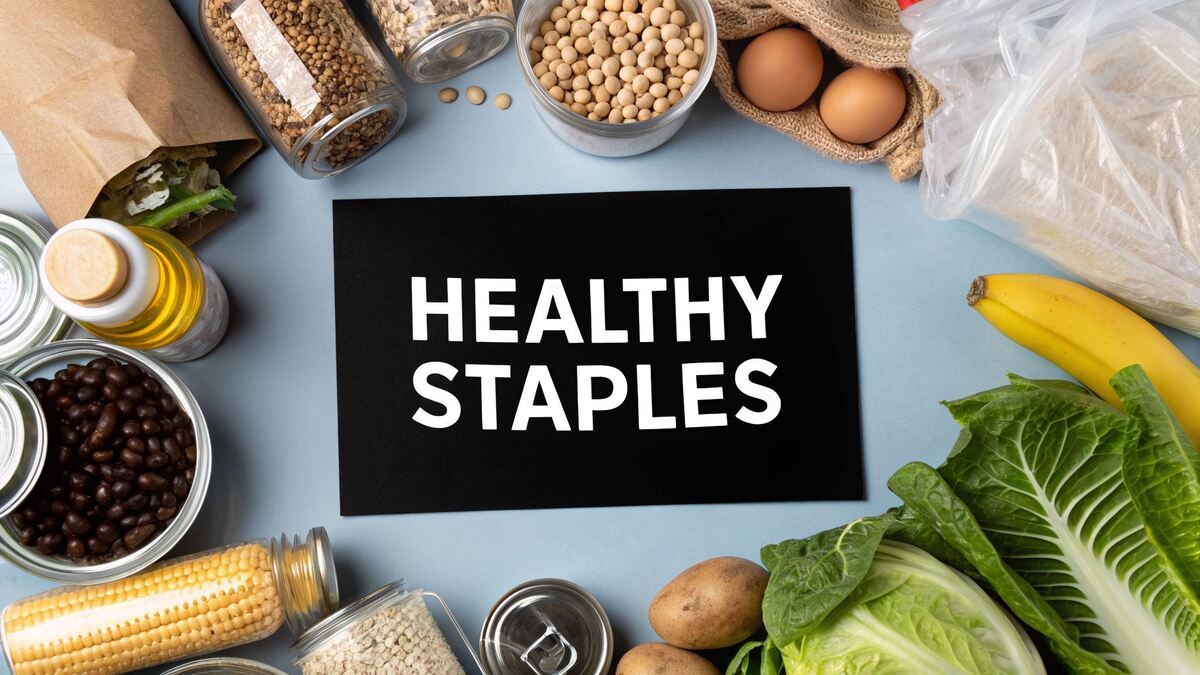Your 2025 Cheap Healthy Grocery Shopping List: 10 Staples
Building a nutritious diet doesn't require an extravagant budget. The foundation of smart, healthy eating lies in knowing which high-impact, low-cost foods to prioritize. This comprehensive guide breaks down the top 10 staples that should form the core of any cheap healthy grocery shopping list.
We move beyond generic advice to provide specific cost-per-serving breakdowns, practical meal ideas, and storage tips to help you maximize every dollar. Forget the idea that healthy food is expensive; it's time to stock your pantry with powerhouse ingredients that fuel your body and protect your wallet. This guide will show you how to transform simple, affordable items into delicious, satisfying meals that support your health goals week after week.
Each item on this list has been selected for its exceptional nutritional value, versatility, and rock-bottom price point, proving that financial wellness and physical wellness can go hand-in-hand. Beyond sourcing store-bought items, understanding how to start growing your own vegetables more effectively can be another powerful strategy for saving money. Whether you’re meal prepping for a busy week or cooking for a family, these pantry essentials will become your go-to resources for creating nutritious, budget-friendly dishes.
1. Dried Beans and Lentils
Dried legumes like beans and lentils are foundational to any cheap healthy grocery shopping list. As one of the most cost-effective sources of plant-based protein and fiber, they offer incredible nutritional value for a fraction of the cost of animal proteins. A single one-pound bag of dried black beans, for example, can yield over 10 servings for around $1.50, making them a true budget superstar.
Their versatility is unmatched. You can easily whip up hearty lentil soup for a complete meal that feeds a family of four for under $5, or make homemade hummus with chickpeas at a third of the cost of store-bought versions. Incorporating them into your diet is a simple way to boost your intake of essential nutrients like iron, folate, and magnesium.
Key Nutrition & Cost Breakdown
To fully appreciate their value, it's helpful to see the numbers side-by-side. The following summary box highlights why dried legumes are such a powerful addition to your pantry.

The data clearly shows that for an incredibly low cost per serving, you get a substantial amount of protein, all from an ingredient that can last for years in your pantry.
Practical Tips for Preparation
Cooking dried beans from scratch is simple, especially with a few time-saving tricks.
- Soak Overnight: Submerging beans in water for 8-12 hours reduces cooking time and makes them easier to digest.
- Pressure Cook: Use an Instant Pot or pressure cooker to cook most beans in under 30 minutes, a 70% time reduction.
- Batch Cook & Freeze: Cook a large batch on the weekend and freeze in 1.5-cup portions (the equivalent of one can) for quick weeknight meals.
For a visual guide on cooking perfect beans every time, check out this helpful video:
By mastering dried beans, you unlock countless affordable and nutritious meal options. For more ideas on how to build plant-forward meals, explore these vegetarian meal plans.
2. Oats (Old-Fashioned or Steel-Cut)
Oats are a cornerstone of any cheap healthy grocery shopping list, serving as an incredibly economical whole grain. Packed with soluble fiber, particularly beta-glucan, they provide sustained energy and support heart health. Buying a large container of old-fashioned or steel-cut oats dramatically reduces the cost per serving, making it a far superior choice over sugary, processed breakfast cereals.
Their versatility extends well beyond the breakfast bowl. You can easily make overnight oats with banana and peanut butter for a grab-and-go meal costing around $0.50 per serving, or blend them into a fine flour for healthier baking. Oats also serve as a fantastic binder in meatballs or veggie burgers, proving their value in both sweet and savory dishes while boosting fiber and nutrient content.
Key Nutrition & Cost Breakdown
To understand their exceptional value, it's useful to look at the numbers. The following summary box highlights why oats are a powerful and budget-friendly addition to your grocery cart.
Oats at a Glance:
- Average Cost: $0.15 - $0.25 per serving (1/2 cup, dry)
- Key Nutrients: Excellent source of manganese, phosphorus, and magnesium. High in soluble fiber.
- Cost Savings: Buying a 42 oz canister for around $4 yields nearly 30 servings, a fraction of the cost of instant oatmeal packets or cereal.
This data clearly shows that for an extremely low cost per serving, you get a filling, nutrient-dense food that supports long-term health and satiety.
Practical Tips for Preparation
Preparing oats is simple and can be adapted to fit any schedule with a few easy techniques.
- Toast for Flavor: Lightly toast dry oats in a pan for 3-5 minutes before cooking to bring out a rich, nutty flavor.
- Batch Cook: Prepare a large batch of steel-cut oats at the beginning of the week and reheat individual portions for quick breakfasts.
- Overnight Oats: Combine oats with your favorite milk and mix-ins in a jar and refrigerate overnight. No cooking required.
- Use as a Binder: Substitute up to one-third of the breadcrumbs in recipes like meatloaf or burgers with rolled oats for added fiber and moisture.
By incorporating oats into your meal plan, you unlock countless affordable, healthy, and satisfying meal possibilities. For more ideas on structuring your morning meals, explore these high-protein breakfast plans.
3. Eggs
Eggs are often called nature's multivitamin, and for good reason. They are one of the most affordable and accessible sources of complete protein, containing all nine essential amino acids required by the human body. Beyond protein, they are packed with healthy fats, vitamin D, B vitamins, and choline, making them a powerhouse of nutrition that belongs on any cheap healthy grocery shopping list.

Their versatility is a major asset for budget-conscious meal planning. You can make a vegetable frittata using leftover produce that serves four people for under $2, or stretch leftover rice into a satisfying egg fried rice. Their ability to fit into any meal, from a quick breakfast scramble to a hearty dinner shakshuka, helps prevent meal fatigue while keeping costs extremely low.
Key Nutrition & Cost Breakdown
To understand their exceptional value, consider the nutritional return on your small investment. A dozen eggs can often be purchased for under $3, providing an incredibly low-cost source of high-quality nutrients that support muscle health and brain function.
A single large egg provides approximately 6 grams of protein and 70 calories for as little as $0.20 per serving. This makes them a more cost-effective protein source than many meats.
Practical Tips for Preparation & Storage
Getting the most out of your eggs is simple with a few key strategies. These tips ensure freshness, maximize value, and make meal prep a breeze.
- Test for Freshness: Gently place an egg in a bowl of water. Fresh eggs sink to the bottom, while older ones will float, indicating they should be discarded.
- Buy the Best Value: Don't assume brown eggs are healthier; their nutritional content is identical to white eggs, so buy whichever is cheaper. Check the price per ounce to see if the largest size offers the best deal.
- Batch-Prep Snacks: Hard-boil a dozen eggs at the start of the week for a quick, portable, high-protein snack or to add to salads and sandwiches.
- Store Properly: Keep eggs in their original carton in the coldest part of your refrigerator, not on the door where temperatures fluctuate.
By incorporating eggs into your routine, you ensure a steady supply of affordable, high-quality protein. To discover more ways to build your diet around powerful protein sources, explore these high-protein meal plans.
4. Frozen Vegetables
Frozen vegetables are a non-negotiable staple for any cheap healthy grocery shopping list. Because they are flash-frozen at peak ripeness, they often retain more vitamins and minerals than fresh produce that travels long distances to the store. This process locks in nutrients, offering consistent quality and flavor year-round, regardless of seasonality. Best of all, they eliminate food waste since you only use what you need, making them an incredibly cost-effective choice.
Their convenience is a game-changer for busy weeknights. A bag of frozen stir-fry vegetables can become a complete meal in minutes, and adding a handful of frozen spinach to a smoothie instantly boosts its nutritional value. A 10-ounce bag of frozen broccoli, for instance, costs around $1.25 and provides several servings, offering significant savings over its fresh counterpart, especially when out of season.
Key Nutrition & Cost Breakdown
To fully appreciate their value, it's helpful to see how frozen vegetables stack up. The following summary highlights why they are such a powerful and affordable addition to your freezer.

The data confirms that for an extremely low price per serving, you get nutrient-dense vegetables with zero prep time and zero waste. This makes healthy eating both accessible and affordable.
Practical Tips for Preparation
Getting the best texture and flavor from frozen vegetables is easy with a few simple techniques.
- Roast, Don't Steam: For a crispier, more flavorful result, toss frozen vegetables like broccoli or cauliflower in oil and spices, then roast at a high temperature (400-425°F) without thawing first.
- Buy Plain: Opt for plain, unsauced vegetables to control your own sodium and seasoning levels. Store brands often offer savings of 30% or more.
- Add Directly to Dishes: Save time by adding frozen peas, corn, or spinach directly into simmering soups, stews, and pasta sauces during the last few minutes of cooking.
By keeping your freezer stocked with frozen vegetables, you ensure a nutritious meal is always within reach. For more inspiration on incorporating vegetables into every meal, check out these customizable meal plans.
5. Bananas
Bananas are a must-have on any cheap healthy grocery shopping list, standing out as one of the most consistently affordable fresh fruits available. They provide a quick source of natural energy, potassium, and vitamin B6. Packaged in their own convenient wrapper, they are a perfect grab-and-go snack that requires no prep work, and their natural sweetness is a healthy way to curb sugar cravings.
Their versatility extends far beyond a simple snack. You can blend frozen bananas into a creamy, one-ingredient "nice cream" for a guilt-free dessert, or pair one with peanut butter for a satisfying snack that costs under $0.50. In baking, a mashed banana can serve as a vegan egg substitute (one banana per egg), adding moisture and sweetness to recipes like banana oatmeal pancakes.
Key Nutrition & Cost Breakdown
To understand why bananas are a budget-friendly powerhouse, it helps to see the numbers. The following summary box highlights their impressive nutritional value for an exceptionally low price point, making them a staple for health-conscious shoppers.
Bananas: Budget-Friendly Nutrition
- Average Cost: $0.50 - $0.70 per pound
- Cost Per Serving (1 medium banana): Approx. $0.20
- Key Nutrients: Excellent source of Potassium, Vitamin B6, and Vitamin C.
- Protein Per Serving: ~1.3g
- Dietary Fiber Per Serving: ~3.1g
This data confirms that for just a few cents, you get a nutrient-dense food that supports everything from heart health to digestion.
Practical Tips for Preparation
Making the most of your bananas is easy with a few simple strategies to extend their freshness and utility.
- Buy at Different Stages: Purchase a mix of green and yellow bananas to ensure you have a steady supply of ripe ones throughout the week.
- Freeze Overripe Bananas: Don't toss brown bananas. Peel, slice, and freeze them in a reusable bag for future smoothies, baking, or nice cream.
- Separate the Bunch: To slow down the ripening process, separate the bananas from the main stem. This reduces the concentration of ethylene gas.
By incorporating these tips, you can maximize the value of this incredibly affordable fruit.
6. Brown Rice and Whole Grains
Brown rice and other whole grains like quinoa and barley are essential for any cheap healthy grocery shopping list. As complex carbohydrates, they provide sustained energy, fiber, and vital nutrients for a very low price. A one-pound bag of brown rice can create the foundation for more than 15 servings, making it an incredibly efficient way to build filling and nutritious meals.
Their versatility is a major advantage for budget cooking. You can create a simple brown rice bowl with beans and vegetables for under $2 per meal or use leftovers to make fried rice with frozen veggies. Grains like barley add a hearty texture and nutritional boost to soups, helping to stretch more expensive ingredients like meat or chicken while keeping you full and satisfied.
Key Nutrition & Cost Breakdown
To understand their value, it's helpful to see the numbers. The following summary highlights why whole grains are such a powerful addition to your pantry, offering a fantastic return on your investment in both cost and nutrition.
Brown Rice (1 cup cooked):
- Approx. Cost Per Serving: $0.20
- Calories: ~215
- Protein: ~5g
- Fiber: ~3.5g
- Key Nutrients: Manganese, Selenium, Magnesium
The data shows that for mere pennies per serving, you get a significant amount of dietary fiber and essential minerals from an ingredient with a long shelf life.
Practical Tips for Preparation
Cooking perfect whole grains is easy and ideal for meal prep.
- Batch Cook for the Week: Cook a large batch on Sunday to use in various meals, saving you time on busy weeknights.
- Perfect Texture Ratio: For fluffy brown rice, use a ratio of 1 cup of rice to 2.5 cups of water.
- Cool Before Storing: Let cooked rice cool completely before refrigerating to prevent it from becoming sticky or soggy.
- Freeze for Convenience: Freeze cooked grains in portion-sized bags. They reheat perfectly in the microwave for a quick meal base.
Mastering a few whole grains opens up a world of affordable and healthy meal possibilities. For ideas on incorporating these staples into balanced meals, check out these customized meal plans.
7. Canned Tomatoes
Canned tomatoes are an indispensable pantry staple for anyone building a cheap healthy grocery shopping list. Surprisingly, they can be more nutritious than fresh tomatoes in certain aspects; the canning process makes the powerful antioxidant lycopene more bioavailable. This makes them a shelf-stable, affordable powerhouse that can transform a few simple ingredients into a deeply flavorful meal.
Their versatility is a major advantage for budget cooking. You can create a simple, rich marinara sauce to feed a family for under $3, use them as a hearty base for chili, or blend them into a creamy tomato soup. A can of crushed tomatoes is the foundation for shakshuka, a delicious and protein-packed meal of eggs poached in a savory tomato and pepper sauce.
Key Nutrition & Cost Breakdown
Canned tomatoes deliver significant nutritional benefits at an exceptionally low price point. They are an excellent source of Vitamin C and lycopene, a potent antioxidant linked to reduced risk of certain diseases. A standard 28-ounce can often costs less than $2 and provides the base for multiple meals. Their long shelf life means you can stock up when they are on sale, reducing food waste and saving money over time.
Practical Tips for Preparation
Getting the most out of canned tomatoes is easy with a few simple guidelines.
- Go Whole: Whole peeled tomatoes often provide the best texture and value. You can crush them by hand for a rustic sauce or blend them for a smoother consistency.
- Control Sodium: Look for "no salt added" varieties to have full control over the sodium content in your dishes.
- Stock Up Smart: Canned goods have a long shelf life, so buy in bulk during sales to maximize your savings.
- Store Properly: Transfer any unused portion from the can into a glass or plastic container and refrigerate for up to five days.
By keeping canned tomatoes on hand, you ensure you always have the foundation for a quick, healthy, and affordable meal. To see how they fit into a balanced diet, explore these Mediterranean meal plans.
8. Peanut Butter
Peanut butter is a powerhouse of affordable nutrition and a must-have for any cheap healthy grocery shopping list. As a shelf-stable source of plant-based protein, healthy monounsaturated fats, and essential nutrients like magnesium and vitamin E, it provides sustained energy and promotes satiety, keeping you full for longer. A standard jar offers numerous servings, often costing just pennies per tablespoon.
Its versatility makes it an invaluable pantry staple. You can create a classic peanut butter and banana sandwich for a quick lunch under $0.50, whip up a savory Thai-inspired peanut sauce for noodles and vegetables, or boost your breakfast by stirring it into oatmeal. Natural varieties, which contain only peanuts and a touch of salt, are the healthiest choice, avoiding the added sugars and hydrogenated oils found in many conventional brands.
Key Nutrition & Cost Breakdown
To understand its value, it's essential to look at the numbers. Peanut butter delivers a significant amount of protein and healthy fats for a very low cost, making it a fantastic ingredient for budget-conscious meal planning. It's an efficient way to add flavor, calories, and nutrients to a wide range of meals and snacks.
Practical Tips for Preparation
Maximizing the value of peanut butter is simple with a few smart strategies.
- Choose Natural: Opt for brands with only two ingredients: peanuts and salt. This ensures you get all the benefits without unhealthy additives.
- Store it Right: To prevent the natural oil from separating, store the jar upside down in your pantry. Give it a good stir when you open it.
- Buy in Bulk: Larger containers typically offer a much better price per ounce, saving you money in the long run.
- Think Savory: Don't limit peanut butter to sandwiches. Use it to add richness and depth to savory dishes like African peanut stew or marinades for chicken or tofu.
9. Sweet Potatoes
Sweet potatoes are nutrient-dense powerhouses and a cornerstone of any cheap healthy grocery shopping list. Loaded with complex carbohydrates, fiber, and an incredible amount of vitamin A, they offer far more nutritional bang for your buck than regular white potatoes. A single large sweet potato can often be found for under a dollar, providing a satisfying and versatile base for multiple meals.
Their natural sweetness makes them a fantastic ingredient for both savory and sweet dishes. You can easily create a complete meal like a baked sweet potato topped with black beans and salsa for around $1.50, or mash them as a nutrient-rich side dish. This versatility ensures they are never a boring addition to your meal plan, helping you stick to a healthy diet without feeling deprived.
Key Nutrition & Cost Breakdown
The nutritional profile of sweet potatoes is impressive, especially considering their low cost. They provide sustained energy and are packed with antioxidants, making them a smart choice for health-conscious shoppers on a budget.
- Average Cost: $0.90 - $1.50 per pound
- Key Nutrients: Vitamin A (over 400% of your daily value in one potato), Vitamin C, Manganese, Fiber
- Why It's a Smart Buy: Sweet potatoes offer an exceptional amount of micronutrients for a very low price. Their long shelf life for a fresh vegetable also helps reduce food waste, further stretching your grocery budget.
The combination of affordability, dense nutrition, and long-lasting freshness makes them an undeniable staple.
Practical Tips for Preparation
Getting the most out of sweet potatoes is easy with a few simple techniques that save time and boost flavor.
- Quick Cook: For a fast-baked potato, pierce the skin with a fork and microwave for 5-8 minutes until tender.
- Leave the Skin On: The skin is packed with fiber and nutrients, so give it a good scrub and eat it for maximum health benefits.
- Roast for Flavor: Cut sweet potatoes into cubes, toss with a little oil and seasoning, and roast at 425°F (220°C) until the edges are caramelized and crispy.
- Proper Storage: Store them in a cool, dark place like a pantry, not the refrigerator. Cold temperatures can negatively affect their texture and taste.
10. Cabbage
Cabbage is one of the most economical vegetables available, making it an essential item on any cheap healthy grocery shopping list. Often costing less than $0.50 per pound, it delivers significant volume, satisfying crunch, and impressive nutrition. A single head can provide over a dozen servings and stays fresh in the refrigerator for weeks, minimizing food waste and maximizing value.
Its versatility is a key advantage for budget cooking. You can shred an entire head to make coleslaw that serves as a side dish for multiple meals, or add it to tacos as a crunchy, cost-effective alternative to lettuce. As a cruciferous vegetable, it's packed with vitamin C, vitamin K, and beneficial plant compounds, offering a substantial health boost for a minimal price.
Key Nutrition & Cost Breakdown
To understand its true value, it helps to see how cabbage stacks up in terms of cost and nutrition. A single head of cabbage can be the base for numerous healthy, low-calorie meals.
- Average Cost: Around $0.49 per pound.
- Key Nutrients: Excellent source of Vitamin K (68% DV per cup) and Vitamin C (36% DV per cup).
- Low Calorie: Only about 22 calories per chopped cup.
- Longevity: Can last 3-4 weeks when stored properly in the crisper drawer.
This combination of low cost, long shelf life, and high nutrient density makes cabbage a powerful tool for stretching your grocery budget without sacrificing health.
Practical Tips for Preparation
Getting the most out of a head of cabbage is easy with a few simple techniques.
- Store It Smart: To keep the head fresh longer, only cut off what you need and store the rest tightly wrapped in the refrigerator.
- Tenderize for Salads: For raw preparations like coleslaw, thinly slice the cabbage, place it in a colander with a sprinkle of salt, and let it sit for 20 minutes. This draws out moisture and creates a more tender texture.
- Versatile Cooking: Sauté cabbage with onions and caraway seeds for a classic flavor combination, or add it to soups and stews during the last 10 minutes of cooking to retain some of its crunch.
- Make Sauerkraut: Fermenting cabbage into sauerkraut is a simple way to create a probiotic-rich food that can last for months.
Affordable Healthy Grocery Items Comparison
| Item | Implementation Complexity 🔄 | Resource Requirements ⚡ | Expected Outcomes 📊 | Ideal Use Cases 💡 | Key Advantages ⭐ |
|---|---|---|---|---|---|
| Dried Beans and Lentils | Moderate: soaking and long cooking time | Low cost, long shelf life | High protein & fiber; sustained energy | Bulk cooking, versatile meals, budget-friendly | Very affordable, sustainable, nutrient-dense |
| Oats (Old-Fashioned or Steel-Cut) | Low: simple cooking (20-30 mins for steel-cut) | Very low cost, minimal equipment | Steady energy, heart health benefits | Breakfast, baking, savory dishes | Affordable, cholesterol-lowering, versatile |
| Eggs | Low: very quick to prepare | Moderate cost per egg, refrigeration needed | Complete protein, essential nutrients | Any meal, quick protein | Highly bioavailable protein, versatile |
| Frozen Vegetables | Very Low: no prep needed | Requires freezer space | Preserved nutrients, minimal waste | Soups, stir-fries, smoothies | Long shelf life, year-round availability |
| Bananas | Very Low: ready to eat | Low cost per banana | Quick energy, potassium-rich | Snacks, smoothies, baking | Portable, naturally sweet, no prep |
| Brown Rice and Whole Grains | Moderate: longer cooking time (40-50 mins) | Low cost, bulk purchase | Complex carbs, sustained energy | Meal bases, batch cooking | Economical, nutritious alternative to white rice |
| Canned Tomatoes | Very Low: ready to use | Low to moderate cost, pantry stable | Rich in lycopene, vitamin C | Sauces, soups, stews | Shelf stable, nutrient-enhanced by processing |
| Peanut Butter | Very Low: no prep | Moderate cost per serving | Protein and healthy fats | Snacks, sauces, cooking | Shelf stable, energy dense, versatile |
| Sweet Potatoes | Moderate: longer cooking (45-60 mins baked) | Low to moderate cost per serving | High vitamin A and fiber | Roasting, baking, mashing | Nutrient-dense, naturally sweet |
| Cabbage | Low: simple prep (chop, cook, or raw) | Very low cost per serving | High vitamin C, vitamin K, antioxidant-rich | Raw, cooked, fermented dishes | Long shelf life, very affordable, versatile |
From List to Lifestyle: Integrating Your Budget-Friendly Staples
Moving from a simple list of groceries to a sustainable, healthy lifestyle is where the real transformation happens. We've explored ten incredibly versatile and affordable staples, from protein-packed lentils and eggs to nutrient-rich sweet potatoes and frozen vegetables. The true power of this cheap healthy grocery shopping list isn't just in the individual items, but in how they work together to form a resilient foundation for your weekly meals.
By stocking your pantry and fridge with these core ingredients, you create a system that is adaptable and cost-effective. You are no longer at the mercy of every supermarket whim or fluctuating food prices. Instead, you have a reliable base to build upon, allowing you to get creative while keeping your budget and health goals firmly in check.
Turning Knowledge into Action
The ultimate goal is to integrate these staples so seamlessly into your routine that healthy eating becomes second nature. This doesn't happen overnight; it happens through consistent, small actions. The key is to shift your mindset from "what should I eat tonight?" to "what can I create with the powerful ingredients I already have?"
Here are some practical next steps to put this guide into practice:
- The "7-Day, 7-Item" Challenge: Pick at least seven items from our list and challenge yourself to build your entire week of meals around them. This exercise forces creativity and demonstrates just how versatile these simple foods can be.
- Master a "Base Recipe" for Each Staple: For example, perfect a simple lentil soup, a go-to overnight oats recipe, or a versatile black bean burger. Having these core recipes in your arsenal eliminates decision fatigue and makes meal prep effortless.
- Plan Around Your Staples: Before you even think about your weekly grocery run, plan your meals using the items you intend to buy from this list. This strategic approach ensures nothing goes to waste and every dollar is spent with purpose.
The Power of a Structured Plan
Once you have your budget-friendly staples, the next step is to integrate them effectively into your daily routine. This often involves creating a well-thought-out plan, such as exploring different approaches to structured meal plans for weight loss to ensure you are meeting specific nutritional targets. A structured approach removes the guesswork, especially when you're aiming for specific outcomes like weight management, muscle gain, or simply more consistent energy levels throughout the day.
Ultimately, mastering your grocery list is about more than just saving money. It's about taking control of your health, reducing food waste, and simplifying your life. By building your diet around these affordable, nutrient-dense powerhouses, you are investing in your long-term well-being without straining your wallet. You have the blueprint; now it's time to build your healthier future, one smart grocery trip at a time.
Ready to turn your grocery list into a personalized, effortless weekly menu? The AI Meal Planner takes these budget-friendly staples and instantly generates a custom meal plan tailored to your exact health goals, dietary needs, and taste preferences. Stop guessing and start eating smarter by visiting AI Meal Planner to create your perfect plan today.
AI-powered nutrition
Get Your Personalized Meal Plan
AI creates the perfect meals for your goals, lifestyle, and taste.
Start Your Journej
